Voyo V3 Review - A Fanless Intel Atom x7-Z8700 (Cherry Trail) mini-PC
by Ganesh T S on March 1, 2016 8:00 AM EST- Posted in
- Systems
- Intel
- Atom
- Passive Cooling
- Mini-PC
- Cherry Trail
Performance Metrics - II
In this section, we mainly look at benchmark modes in programs used on a day-to-day basis, i.e, application performance and not synthetic workloads.
x264 Benchmark
First off, we have some video encoding benchmarks courtesy of x264 HD Benchmark v5.0. This is simply a test of CPU performance. As expected, the Broadwell cores in the ECS LIVA Core perform way better compared to the Atom cores in other products. Between the Atom-based products, the four physical cores in the x7-Z8700 and the higher core clocks help the Voyo V3 edge out the other products in this benchmark.

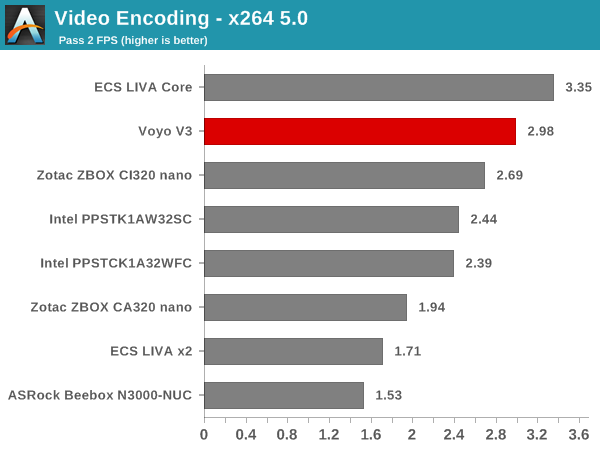
7-Zip
7-Zip is a very effective and efficient compression program, often beating out OpenCL accelerated commercial programs in benchmarks even while using just the CPU power. 7-Zip has a benchmarking program that provides tons of details regarding the underlying CPU's efficiency. In this subsection, we are interested in the compression and decompression MIPS ratings when utilizing all the available threads. These results are actually a bit surprising - perhaps, indicative of the fact that physical threads perform better than hyper-threaded resources when it comes to 7-Zip. Note that the Atom x7-Z8700 in the Voyo V3 has four physical cores compared to the 2C/4T configuration of, say, the Core M-5Y10c in the ECS LIVA Core.
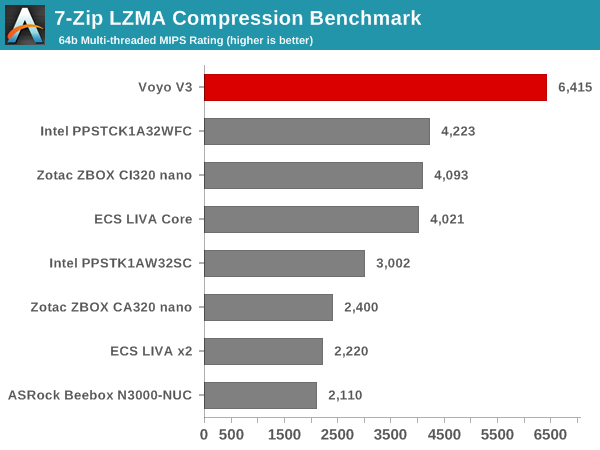
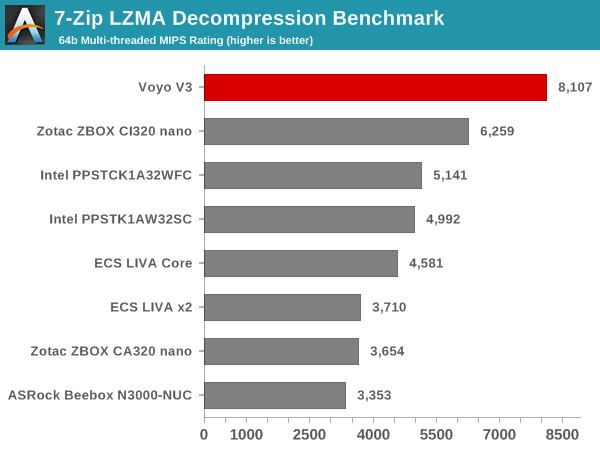
TrueCrypt
As businesses (and even home consumers) become more security conscious, the importance of encryption can't be overstated. CPUs supporting the AES-NI instruction for accelerating the encryption and decryption processes have, till now, been the higher end SKUs. However, with Bay Trail, even the lowly Atom series has gained support for AES-NI. This has migrated down to Cherry Trail also. The Atom x7-Z8700 in the Voyo V3 does have AES-NI support. TrueCrypt, a popular open-source disk encryption program can take advantage of the AES-NI capabilities. The TrueCrypt internal benchmark provides some interesting cryptography-related numbers to ponder. In the graph below, we can get an idea of how fast a TrueCrypt volume would behave in the Voyo V3 and how it would compare with other select PCs. This is a purely CPU feature / clock speed based test.
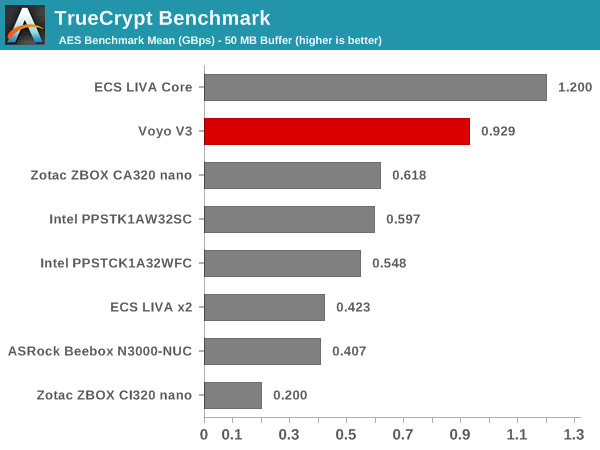
Agisoft Photoscan
Agisoft PhotoScan is a commercial program that converts 2D images into 3D point maps, meshes and textures. The program designers sent us a command line version in order to evaluate the efficiency of various systems that go under our review scanner. The command line version has two benchmark modes, one using the CPU and the other using both the CPU and GPU (via OpenCL). The benchmark takes around 50 photographs and does four stages of computation:
- Stage 1: Align Photographs
- Stage 2: Build Point Cloud (capable of OpenCL acceleration)
- Stage 3: Build Mesh
- Stage 4: Build Textures
We record the time taken for each stage. Since various elements of the software are single threaded, others multithreaded, and some use GPUs, it is interesting to record the effects of CPU generations, speeds, number of cores, DRAM parameters and the GPU using this software.
In this real-world benchmark, the situation is not as clear-cut as in the other cases. In general, the LIVA Core is the most effective. However, the Voyo V3 doesn't consistently come in second. It could have a lot to do with the memory sub-system (while most of the PCs we have evaluated before are DDR3L-based, the Voyo V3 has LPDDR3 DRAM).
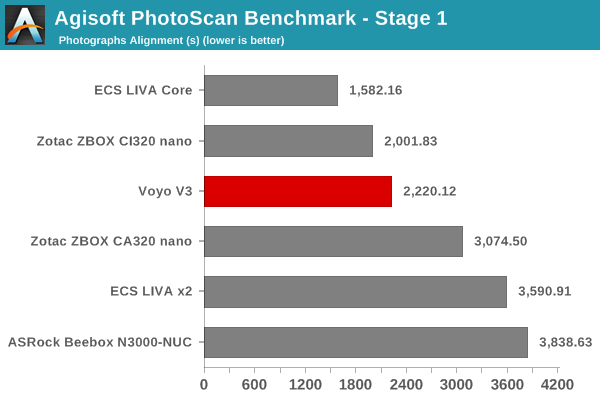
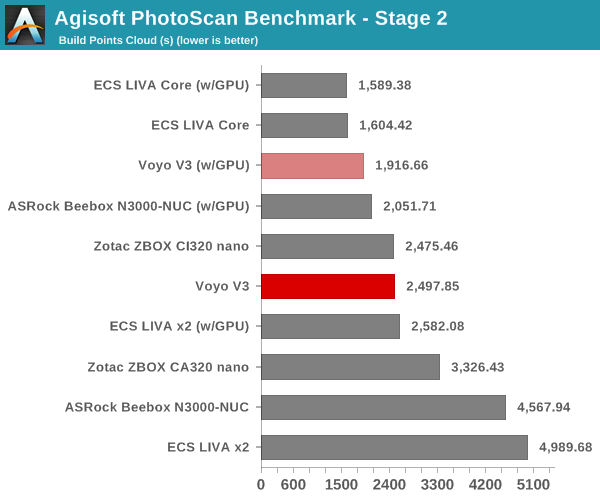
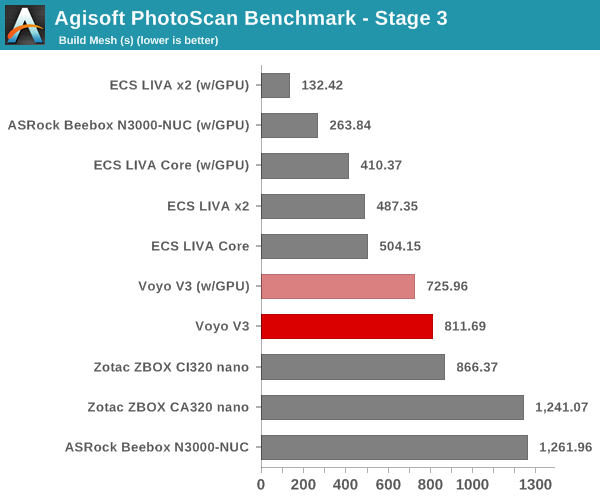

Dolphin Emulator
Wrapping up our application benchmark numbers is the Dolphin Emulator benchmark mode results. This is again a test of the CPU capabilities, and the results track what we have seen in the previous benchmarks.











69 Comments
View All Comments
Pissedoffyouth - Tuesday, March 1, 2016 - link
I wish Intel could sort out it's Atom Linux support. Something like this with Linux support would be fantastic. It's been like 3 years and my Asus t100 Baytrail still doesn't work properly 100% without invasive patches for its kernel.BrokenCrayons - Tuesday, March 1, 2016 - link
I've had endless problems getting Linux working on an Asus X205TA that's got a Bay Trail to the point where I've given up on it and it's basically a Windows paperweight sitting in a drawer. HP was a lot better/easier with the Stream 11, but even it isn't as easy as it ought to be to get a proper operating system installed. The hardware specs on these low end Atoms with their passive cooling and low price make them perfect candidates for Linux. I'm not one to spread conspiracy theories, but I think that there's been active work put into the idea of preventing people from easily abandoning Windows on cheaper systems. After all, if Microsoft is giving the OS away for free, they need to recoup their costs through targeted advertising and the Windows Store so the last thing Microsoft would want is the end user population hopping onto an OS where they don't reap any financial return.PsychoPif - Wednesday, March 2, 2016 - link
"I'm not one to spread conspiracy theories, "Except you just did :)
Unless you can provide any shadow of a doubt, I'll keep beliving it has more to do with the fact that Linux is too small of a market to warrant the cost for the hardware maker.
BrokenCrayons - Wednesday, March 2, 2016 - link
I might be mistaken, but the number of computing devices running a Linux kernel is currently higher than those running a Microsoft built kernel. While a lot of that is due to Android, there's also super computer dominance and other fringe markets. Because of Microsoft's recent missteps with Windows 8's user interface and privacy concerns that arose due to Windows 10 telemetry, I think there's a reason for shareholders to be concerned. It didn't take that many years for the Linux kernel to reach a dominant state in the mobile sector. Yes, on desktop and laptop PCs, the market share is about 1.7% running Linux, but that traditional computing model is mature and even in a state of decline as mobile devices running alternative operating systems are apparently taking sales. As handsets have proven, change can happen quickly. It's in Microsoft's best interest, particularly with Secure Boot, to implement mechanisms that help to achieve ecosystem lock-in.Flunk - Tuesday, March 1, 2016 - link
I don't think it's Intel's problem that the Linux kernel has compatibility issues with their hardware. Microsoft initially had some problems with bay trail and cherry trail too, but they fixed their issues. The issues are mostly concerned with certain hardware things these SoCs no longer have that OSes assume x86 chips have. It's not an issue with the hardware.Flunk - Tuesday, March 1, 2016 - link
Also, I should follow this up with the standard open-source argument. If you want bay trail/cherry trail support then you should write it yourself.eek2121 - Thursday, March 3, 2016 - link
I'm not normally one to agree with a troll, but thank you Flunk, as someone who has read that very line across many different open source projects...you made my night. I said this 15 years ago, and i'll say it again. The open source world has 3 problems when it comes to open source adoption. The biggest one is the asshole community. Fix that issue and you'll go a long way towards widespread open source adoption. Unfortunately, there is no shortage of assholes out there...so good luck!sprockkets - Tuesday, March 1, 2016 - link
I'm on such a cpu right now, the Pentium 3700. About the only issues with Linux are video, and the drivers for it are from Intel, open source as well.What is weirder is that video wise, Android works way better than typical Linux. Probably because it doesn't use X. I'd look into Remix OS or the Android x86 project. Best part of the latter is you'll have no issue with updates or upgrades vs the typical android tablet.
extide - Wednesday, March 2, 2016 - link
No, it is an issue with Intel because they should be submitting the patches and drivers to make stuff work properly.Camikazi - Wednesday, March 2, 2016 - link
But it's Linux, if it doesn't work you can fix it yourself, isn't that the big thing about it? I don't think Intel should submit anything to make it work, they do it if they can and if they want to other than that you are on your own making it work.